
17 Apr What you have yet to see in Madrid
Madrid is a city that is home to many artistic, historical and cultural treasures. If Madrid is one of your favourite places to visit, we leave you a list of some of the most unknown special places to enjoy visiting on your next trip. We hope you like it!
La Casa Lope de Vega

The House of Lope de Vega was built in the 16th century and, as its name suggests, was the residence of one of the most important writers of the Golden Age. This house is located on Calle de Cervantes and was declared a monument and inaugurated as a museum in 1935, 300 years after his death.
After the death of the writer, many owners made changes to the place causing the loss of almost all of its original structure; however, when it was acquired by the Royal Academy, they brought back several pieces of furniture that the author’s daughter donated to a church and recreated the original structure of the home when the author lived there. Today visits to the museum are guided and last about 35 minutes.
Parque El Capricho

The city of Madrid has many emblematic and beautiful parks, but one that has a special charm and that most tourists are unaware of is located in Alameda de Osuna: Parque el Capricho.
This park was created by the Dukes of Osuna in 1784 and is home to a wealth of artistic, botanical and sculptural treasures. It also hides a secret: the famous Posición Jaca bunker from the Civil War period, which you can access with a guided tour.
Estación de Chamberí
Chamberí station belongs to the first Metro line inaugurated in the city in 1919. The station was closed in 1966 when the Metropolitan Company decided to extend the length of the trains and realised that it was impossible to extend the station.
With the film Barrio by Fernando León de Aranoa in 1998, this station was brought back to the present day and today it is a museum that conserves a large part of its original elements, where you can visit what the city was like a few decades ago.
Parque Europa

The Parque Europa is located in Torrejón de Ardoz and has reproductions of the most emblematic and important buildings and monuments of the main cities of Europe, which have an informative sign next to them with references to the original monument. It has replicas of 19 European monuments and also a fragment of the original Berlin Wall.
As well as visiting these reproductions, you can enjoy the multi-adventure and leisure areas, and a cybernetic fountain that performs a light, sound and water show. Admission to the park is free.
El túnel de Bonaparte
King Joseph Bonaparte ordered the construction of the Bonaparte Tunnel as an underground passageway to provide him with an escape route that would allow him to move around his domains without going outside. It is a grotto that connects the Royal Palace with the Casa de Campo and the gardens of Madrid Río and is one of the city’s most hidden secrets.
The tunnel is currently closed to the public, but there is already a project to open it with the opening of the Royal Collections Gallery. Today there is a panel that gives access to Madrid Río and contains a map and all the informative details about this tunnel. The other end is a closed door in the Campo del Moro.
Montaña de los Gatos

In 1817 the Montaña Artificial (Artificial Mountain) was located in the Retiro Park. It was a brick structure that housed a waterwheel that moved water from the nearby stream, waterfall and lake that surrounded it.
Twenty years after the closure of this structure and its waterfalls due to problems of water seepage, the Madrid City Council has completely restored the waterfalls and the interior itinerary. There is currently a temporary exhibition where visitors can see the garden area and the renovated exterior structure, as well as a sample of the vaulted interior space. In this temporary exhibition you can learn about the history of the Montaña de los Gatos and it is open from 11am to 1pm and from 6pm to 8pm.



